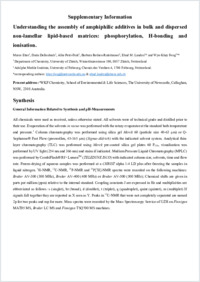Understanding the assembly of amphiphilic additives in bulk and dispersed non-lamellar lipid-based matrices: Phosphorylation, H-bonding and ionisation
- Etter, Marco F. Department of Chemistry, University of Zürich, Switzerland
- Dellenbach, Daria Department of Chemistry, University of Zürich, Switzerland
- Petri-Fink, Alke Adolphe Merkle Institute, University of Fribourg, Switzerland - Department of Chemistry, University of Fribourg, Switzerland
- Rothen-Rutishauser, Barbara Adolphe Merkle Institute, University of Fribourg, Switzerland
- Landau, Ehud M. Department of Chemistry, University of Zürich, Switzerland
- Fong, Wye-Khay Adolphe Merkle Institute, University of Fribourg, Switzerland
-
07.03.2020
Published in:
- Journal of Colloid and Interface Science. - 2020, vol. 562, p. 502–510
English
The aqueous channel size of lipidic cubic phases can be a limiting factor for certain applications. For this reason, additives have been used to exquisitely control their nanostructure. In this study, two families of primary phosphoesters have been designed, synthesised and utilised to determine the effect of the positioning of the guest additive at the interface of the host mesophase, and to contrast the effect of headgroup ionisation and protonation. A general methodology has been developed to produce primary phosphoesters, and a unique use of 31P NMR has been used in order to systematically investigate the influence of these additives on monoolein- and phytantriol-based bulk lipidic cubic phases and dispersed cubosomes. In general, di- phosphorylated additives exhibit a greater effect upon lipid packing than the mono- and tri-phosphorylated molecules due to their optimal positioning. In dispersion, the protonation state of the phosphate headgroups was manipulated by altering the pH, where shifts in pKa determined by 31P NMR were used as a fluorescent label-free method to identify the location and ionisation state of the phosphate additives. This study systematically evaluates the influence of the positioning of the additive, headgroup size and charge of phosphorylated lipids on the behaviour of lipidic mesophases.
- Faculty
- Faculté des sciences et de médecine
- Department
- Département de Chimie, AMI - Bio-Nanomatériaux
- Language
-
- English
- Classification
- Chemistry
- License
-
License undefined
- Identifiers
-
- RERO DOC 328178
- DOI 10.1016/j.jcis.2019.11.087
- Persistent URL
- https://folia.unifr.ch/unifr/documents/308550
Other files
Statistics
Document views: 109
File downloads:
- pdf: 273
- Supplementary material: 212

